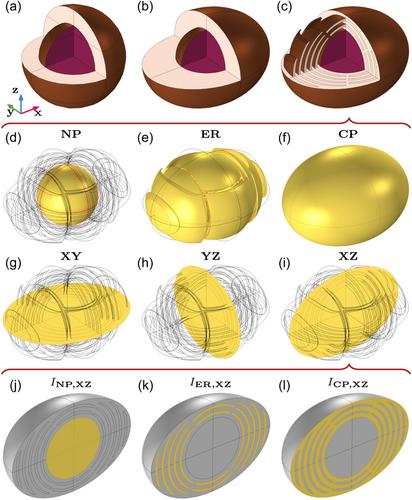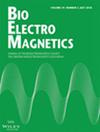Kevin Jerbic, Jan T. Svejda, Benedikt Sievert, Andreas Rennings, Jürg Fröhlich, Daniel Erni
下载PDF
{"title":"亚细胞结构对计算生物电磁学模拟背景下生物细胞建模的重要性","authors":"Kevin Jerbic, Jan T. Svejda, Benedikt Sievert, Andreas Rennings, Jürg Fröhlich, Daniel Erni","doi":"10.1002/bem.22436","DOIUrl":null,"url":null,"abstract":"<p>Numerical investigation of the interaction of electromagnetic fields with eukaryotic cells requires specifically adapted computer models. Virtual microdosimetry, used to investigate exposure, requires volumetric cell models, which are numerically challenging. For this reason, a method is presented here to determine the current and volumetric loss densities occurring in single cells and their distinct compartments in a spatially accurate manner as a first step toward multicellular models within the microstructure of tissue layers. To achieve this, 3D models of the electromagnetic exposure of generic eukaryotic cells of different shape (i.e. spherical and ellipsoidal) and internal complexity (i.e. different organelles) are performed in a virtual, finite element method-based capacitor experiment in the frequency range from 10 Hz to 100 GHz. In this context, the spectral response of the current and loss distribution within the cell compartments is investigated and any effects that occur are attributed either to the dispersive material properties of these compartments or to the geometric characteristics of the cell model investigated in each case. In these investigations, the cell is represented as an anisotropic body with an internal distributed membrane system of low conductivity that mimics the endoplasmic reticulum in a simplified manner. This will be used to determine which details of the cell interior need to be modeled, how the electric field and the current density will be distributed in this region, and where the electromagnetic energy is absorbed in the microstructure regarding electromagnetic microdosimetry. Results show that for 5 G frequencies, membranes make a significant contribution to the absorption losses. © 2023 The Authors. <i>Bioelectromagnetics</i> published by Wiley Periodicals LLC on behalf of Bioelectromagnetics Society.</p>","PeriodicalId":8956,"journal":{"name":"Bioelectromagnetics","volume":"44 1-2","pages":"26-46"},"PeriodicalIF":1.2000,"publicationDate":"2023-02-16","publicationTypes":"Journal Article","fieldsOfStudy":null,"isOpenAccess":false,"openAccessPdf":"https://onlinelibrary.wiley.com/doi/epdf/10.1002/bem.22436","citationCount":"0","resultStr":"{\"title\":\"The Importance of Subcellular Structures to the Modeling of Biological Cells in the Context of Computational Bioelectromagnetics Simulations\",\"authors\":\"Kevin Jerbic, Jan T. Svejda, Benedikt Sievert, Andreas Rennings, Jürg Fröhlich, Daniel Erni\",\"doi\":\"10.1002/bem.22436\",\"DOIUrl\":null,\"url\":null,\"abstract\":\"<p>Numerical investigation of the interaction of electromagnetic fields with eukaryotic cells requires specifically adapted computer models. Virtual microdosimetry, used to investigate exposure, requires volumetric cell models, which are numerically challenging. For this reason, a method is presented here to determine the current and volumetric loss densities occurring in single cells and their distinct compartments in a spatially accurate manner as a first step toward multicellular models within the microstructure of tissue layers. To achieve this, 3D models of the electromagnetic exposure of generic eukaryotic cells of different shape (i.e. spherical and ellipsoidal) and internal complexity (i.e. different organelles) are performed in a virtual, finite element method-based capacitor experiment in the frequency range from 10 Hz to 100 GHz. In this context, the spectral response of the current and loss distribution within the cell compartments is investigated and any effects that occur are attributed either to the dispersive material properties of these compartments or to the geometric characteristics of the cell model investigated in each case. In these investigations, the cell is represented as an anisotropic body with an internal distributed membrane system of low conductivity that mimics the endoplasmic reticulum in a simplified manner. This will be used to determine which details of the cell interior need to be modeled, how the electric field and the current density will be distributed in this region, and where the electromagnetic energy is absorbed in the microstructure regarding electromagnetic microdosimetry. Results show that for 5 G frequencies, membranes make a significant contribution to the absorption losses. © 2023 The Authors. <i>Bioelectromagnetics</i> published by Wiley Periodicals LLC on behalf of Bioelectromagnetics Society.</p>\",\"PeriodicalId\":8956,\"journal\":{\"name\":\"Bioelectromagnetics\",\"volume\":\"44 1-2\",\"pages\":\"26-46\"},\"PeriodicalIF\":1.2000,\"publicationDate\":\"2023-02-16\",\"publicationTypes\":\"Journal Article\",\"fieldsOfStudy\":null,\"isOpenAccess\":false,\"openAccessPdf\":\"https://onlinelibrary.wiley.com/doi/epdf/10.1002/bem.22436\",\"citationCount\":\"0\",\"resultStr\":null,\"platform\":\"Semanticscholar\",\"paperid\":null,\"PeriodicalName\":\"Bioelectromagnetics\",\"FirstCategoryId\":\"99\",\"ListUrlMain\":\"https://onlinelibrary.wiley.com/doi/10.1002/bem.22436\",\"RegionNum\":3,\"RegionCategory\":\"生物学\",\"ArticlePicture\":[],\"TitleCN\":null,\"AbstractTextCN\":null,\"PMCID\":null,\"EPubDate\":\"\",\"PubModel\":\"\",\"JCR\":\"Q3\",\"JCRName\":\"BIOLOGY\",\"Score\":null,\"Total\":0}","platform":"Semanticscholar","paperid":null,"PeriodicalName":"Bioelectromagnetics","FirstCategoryId":"99","ListUrlMain":"https://onlinelibrary.wiley.com/doi/10.1002/bem.22436","RegionNum":3,"RegionCategory":"生物学","ArticlePicture":[],"TitleCN":null,"AbstractTextCN":null,"PMCID":null,"EPubDate":"","PubModel":"","JCR":"Q3","JCRName":"BIOLOGY","Score":null,"Total":0}
引用次数: 0
引用
批量引用


 求助内容:
求助内容: 应助结果提醒方式:
应助结果提醒方式:


